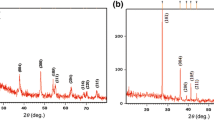Abstract
A novel complex nanostructured TiO2 electrode and fabrication process were proposed and demonstrated to improve the performance of dye-sensitized solar cells (DSSCs). In the proposed process, a nanoporous TiO2 layer was firstly fabricated on the FTO (fluorine-doped tin oxide) conducting substrate by an anodization process, then a nanoparticulate TiO2 film was deposited on the nanoporous TiO2 layer by the screen printed method to form the complex nanostructured TiO2 electrode. The experiments demonstrated that the nanoporous TiO2 layer can enhance the light scattering, decrease the contact resistance between TiO2 electrode and FTO, and suppress the recombination of I 3 − ion with the injected electrons of FTO. The process variables are crucial to obtain the optimized performance of DSSCs. By adopting the optimized process, improved conversion efficiency of DSSCs was achieved at AM 1.5 sunlight.
Similar content being viewed by others
References
O’Regan B, Grätzel B. A low-cost, high-efficiency solar cell based on dye-sensitized colloidal TiO2 films. Nature, 1991, 353: 737–740
Grätzel M. Photoelectrochemical cells. Nature, 2001, 414: 338–344
Chiba Y, Islam A, Watanabe Y, et al. Dye-sensitized solar cells with conversion efficiency of 11.1%. Jpn J Appl Phys, 2006, 45: L638–L640
Hu L, Dai S, Weng J, et al. Microstructure design of nanoporous TiO2 photoelectrodes for dye-sensitized solar cell modules. J Phys Chem B, 2007, 111: 358–362
Jiu J, Isoda S, Adachi M, et al. Preparation of TiO2 nanocrystalline with 3-5 nm and application for dye-sensitized solar cell. J Photoch Photobio A, 2007, 189: 314–321
Zhou Y F, Li X P, Zhang J B, et al. Performances improvement of eosin Y sensitized solar cells by modifying TiO2 electrode with silane-coupling reagent. Chin Sci Bull, 2009, 54: 2633–2640
Nguyen T V, Lee H C, Yang O. The effects of pre-thermal treatment of TiO2 nano-particles on the performances of dye-sensitized solar cells. Sol Energ Mat Sol C, 2006, 90: 967–981
Grätzel M. Dye-sensitized solar cells. J Photoch Photobio C, 2003, 4: 145–153
Ma B B, Gao R, Wang L D, et al. Recent progress in interface modification for dye-sensitized solar cells. Sci China Chem, 2010, 53: 1669–1678
Law M, Greene L E, Johnson J C, et al. Nanowire dye-sensitized solar cells. Nat Mater, 2005, 4: 455–459
Mor G K, Shankar K, Paulose M, et al. Enhanced photocleavage of water using titania nanotube arrays. Nano Lett, 2005, 5: 191–195
Yoon J H, Jang S R, Vittal R, et al. TiO2 nanorods as additive to TiO2 film for improvement in the performance of dye-sensitized solar cells. J Photochem Photobiol A, 2006, 180: 184–188
Luo J Q, Gao L, Sun J, et al. A bilayer structure of a titania nanoparticle/ highly-ordered nanotube array for low-temperature dye-sensi-tized solar cells. RSC Adv, 2012, 2: 1884–1889
Miao Q Q, Wu L Q, Cui J N, et al. A new type of dye-sensitized solar cell with a multilayered photoanode prepared by a film-transfer technique. Adv Mater, 2011, 23: 2764–2768
Wang H, Liu Y, Li M, et al. Hydrothermal growth oflarge-scale macroporous TiO2 nanowires and its application in 3D dye sensitized solar cells. Appl Phys A, 2009, 97: 25–29
Tsai T Y, Lu S Y. A novel way of improving light harvesting in dye-sensitized solar cells-electrodeposition of titania. Electrochem Commun, 2009, 11: 2180–2183
Kang T S, Smith A P, Taylor B E, et al. Fabrication of highly-ordered TiO2 nanotube arrays and their use in dye-sensitized solar cells. Nano Lett, 2009, 9: 601–606
Wang C X, Zhang X D, Wang D F, et al. Synthesis of nanostructural ZnO using hydrothermal method for dye-sensitized solar cells. Sci China Tech Sci, 2010, 53: 1146–1149
Author information
Authors and Affiliations
Corresponding authors
Rights and permissions
About this article
Cite this article
Zhang, T., Liu, L., Yang, F. et al. Improved conversion efficiency of dye-sensitized solar cells by using novel complex nanostructured TiO2 electrodes. Sci. China Technol. Sci. 56, 115–119 (2013). https://doi.org/10.1007/s11431-012-5012-5
Received:
Accepted:
Published:
Issue Date:
DOI: https://doi.org/10.1007/s11431-012-5012-5




